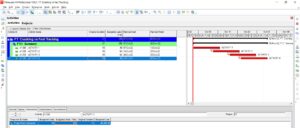The two key schedule compression techniques offer several advantages and disadvantages depending on their application. Fast Tracking and Crashing, both methods can reduce activity durations, but cost, quality, and risks associated should also be considered while applying suitable techniques.
The delays on projects occur due to several reasons, including but not limited to, material unavailability, manpower shortage, work-fronts unavailability, risks, force majeure, poor workmanship, and poor management. So, the schedule compression technique is mostly required to bring the project back on track.
Schedule compression techniques are required to cover the delays on the project and to meet the target dates as per the contract/baseline. The quality or cost will definitely be impacted in doing so. Therefore, proper selection and implementation of these techniques are very much necessary to obtain desired schedule compression results.
What do we mean by Fast Tracking?
In this technique, we compress the schedule by performing some activities in parallel. Here, not all, but a number of activities can also be performed in parallel.
How to perform Fast Tracking?
Below are steps to perform Fast Tracking:
- The project schedule is reviewed in detail. Here, we only consider the activities on the critical path.
- List out all activities that are on the critical path.
- Analyze in detail to filter for activities that can be performed in parallel or at least can be performed partially in parallel.
- Need to recheck the schedule if any other path has become a critical path now.
- If any other path has become critical, then the above steps shall be performed again to reduce project duration where possible.
Fast Tracking through Primavera P6
To understand the concept of Fast-Tracking, the following example from Oracle Primavera P6 is presented:

Here, all activities are on a critical path and the total project duration is 30 days.
After applying the Fast Tracking technique (performing different activities in parallel), the project schedule may look as below:

Here, performing different activities in parallel results in a reduced project duration of 21 days. This is where Fast-Tracking is more useful as it decreases project duration significantly.
What do we mean by Crashing?
When Fast Tracking does not work in the required value of schedule compression, Crashing is applied. In Crashing, the project schedule is compressed by adding additional resources, working additional hours including double shifts, and paying bonuses to workers, etc.
Crashing actually reduces the duration of the project but with additional costs to achieve this.
How to perform Crashing?
Below are steps to perform the crashing technique:
- The project schedule is reviewed in detail
- List out all activities that are on the critical path.
- Identify which activities can be compressed or crashed. Activities that can be completed earlier with minimum cost shall be identified.
- Once activities to be compressed are identified, the overall cost associated with this change is to be calculated.
- After taking due approval from sponsors/approving authorities, the project schedule should be compressed accordingly.
- Need to recheck the schedule if any other path has become a critical path now.
- If any other path has become critical, then the above steps shall be performed again to further compress the
Crashing through Primavera P6
In order to understand the concept of Crashing, the following example from Oracle Primavera P6 is presented:

This image shows 4 activities that all are on the critical path and the overall duration of the project is 27 days. Resources for activities are also shown.
To apply the Crashing technique, we add one additional resource to all activities. Also, need to set the ”Duration Type” to ”Fixed Units/ Time”. This will result in reduced overall duration as follows:

After applying the Crashing technique, the project duration decreased and now it is only 20 days.
Fast Tracking vs Crashing:
Both techniques are key for schedule compression, but their application depends on the project situation as well as on project preferences (cost, quality, risk, time, etc). Project managers need to identify which aspect they are going to compromise on, whether it is cost or quality. But one thing is sure, both of these techniques result in a major impact on the project, either on cost or quality.
The advantages and disadvantages of both techniques are compared below:
- Cost is mostly unaffected in Fast Tracking, while Crashing adds significant cost due to the addition of resources, additional duty hours, perks, etc.
- Both techniques involve risk. Crashing may result in relatively more risk but Fast Tracking can also result in reworks.
- Quality issues are a major drawback of the Fast-Tacking method.
- Fast Tracking is always applied first, while Crashing is applied when Fast Tracking does not provide the required schedule compression.
- Both are applied to the critical path only.
- Fast-Tracking will be applicable only if activities are overlapped while Crashing doesn’t require this condition.
- The sequence of activities is changed in Fast Tracking while in Crashing it does not change.
- A newly assigned team is involved in Crashing which may lack knowledge or experience for a specific job, hence productivity may decrease.
- A high level of flexibility among the project team and stakeholders is required for the successful implementation of the Crashing technique.
- Aside from getting the project back on track, Fast Tracking offers the advantage of the availability of resources for other projects.
When to Fast Track or when to Crash our schedule?
Both techniques have their place in managing projects. Sometimes Fast-Tracking is more suitable while at other times crashing is valuable.
- Depending on the project situation, we can use both of them while in some cases none of these two works.
- Depending on requirements, if a project can be managed through Fast-Tracking, then it is best because the additional cost would not be involved in doing so.
- Depending on project finances, if the client is ready to pay for additional amounts and needs the project to be finished on time in every case, then Crashing is best to apply.
- If we have to preserve the company’s image and reputation in the market, we may need to apply Crashing even if the cost is getting higher.
- If there is the risk of penalty of LDs (Liquidated Damages) due to delay in completion of the project, we may need to calculate the amount of possible penalty and check if it is going beyond Crashing cost, then we should apply both techniques i.e Crashing some of the activities and Fast-Tracking other activities where both techniques are easily applicable.
Conclusion:
Both schedule compression techniques are applied to cover delays and to put the project back on track. Also, there are associated risks and limitations while applying these techniques. Both techniques are applied to critical path activities. Care should be taken after the application of such techniques as there may be activities that were not critical earlier and have become critical now.
Overall, Fast-Tracking should always be tried first and if results are not obtained, then crashing should be applied. The optimum solution is to perform both of these techniques once. The project manager should check for activities that can be performed in parallel, and Fast-Tracking be applied. Where activities can easily be managed with little additional cost, the Crashing technique should be applied.
Fast-Tracking and crashing may not always provide a viable solution, so the best way to manage is to perform risk analysis before applying any of these techniques.
For expert guidance in maximizing your project efficiency, contact Leopard Project Controls, your trusted CPM scheduling consultant.





